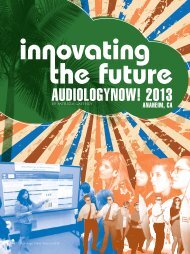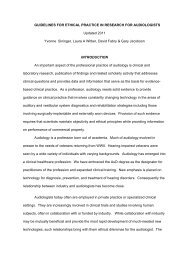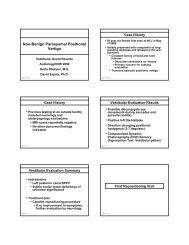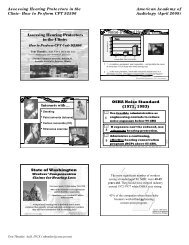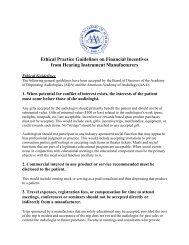HYPERACUSIS: ASSESSMENT AND MANAGEMENT
HYPERACUSIS: ASSESSMENT AND MANAGEMENT
HYPERACUSIS: ASSESSMENT AND MANAGEMENT
You also want an ePaper? Increase the reach of your titles
YUMPU automatically turns print PDFs into web optimized ePapers that Google loves.
Therapy for Hyperacusis:<br />
Audiologic Management Strategies<br />
James W. Hall III, Ph.D.<br />
Department of Communicative Disorders<br />
College of Public Health and Health Professions<br />
University of Florida<br />
Gainesville, Florida<br />
Jwhall3@phhp.ufl.edu<br />
and<br />
Extraordinary Professor<br />
Audiology Division<br />
Department of Communication Pathology<br />
University of Pretoria<br />
South Africa<br />
<strong>HYPERACUSIS</strong>:<br />
Williams Syndrome<br />
� Identified in the early 1960s<br />
� Incidence of 1 in 20,000 live births<br />
� Caused by micro-deletion on chromosome 7q11.23, including ~ 20 genes<br />
� From 50 to 90% of children with WS have hyperacusis<br />
� Features include<br />
� Facial features<br />
� Cognitive deficits, e.g.,<br />
� Conceptual reasoning<br />
� Problem solving<br />
� Arithmetic ability<br />
� Spatial cognition<br />
� Fears and anxieties<br />
� Motor control problems<br />
� Cardiac abnormalities<br />
� Language impairment<br />
� Middle ear disease (otitis media)<br />
Tinnitus and Hyperacusis in Childhood: Preliminary Findings in An APD<br />
Population at the University of Florida (N = 77)<br />
Management of APD May Contribute to Tolerance to Sound<br />
Yes No<br />
Tinnitus 10 (13%) 67 (87%)<br />
Hyperacusis 30 (39%) 47 (61%)<br />
Both Tinnitus & Hyperacusis 8 (10%) 69 (90%)<br />
<strong>HYPERACUSIS</strong>:<br />
A symptom in varied clinical entities (1)<br />
� Central neurological disorders<br />
� Depression<br />
� Migraine<br />
� Chronic fatigue syndrome<br />
� Post-traumatic stress disorder<br />
� Tay Sach’s disease<br />
� Ramsay-Hunt syndrome<br />
� Multiple sclerosis<br />
� Middle cerebral artery aneurysm<br />
� Complex regional pain syndrome related dystonia<br />
� Lyme disease<br />
� Facial paralysis<br />
� Pyrodoxine deficiency<br />
� Benzodiazepine dependency<br />
� William’s syndrome<br />
� Autism<br />
<strong>HYPERACUSIS</strong>:<br />
A symptom of varied clinical entities (2)<br />
� Tinnitus<br />
� Acoustic trauma<br />
� Auto-immune disorders<br />
� Post otologic surgery<br />
� ventilation tubes<br />
� otosclerosis<br />
� tympanoplasty<br />
� Genetic predisposition (family trait)<br />
� Auditory processing disorders (APD)<br />
� Drugs<br />
� Effexor<br />
� Prozac<br />
� Remeron<br />
� Tegretol<br />
� Zoloft<br />
<strong>HYPERACUSIS</strong>:<br />
<strong>ASSESSMENT</strong> <strong>AND</strong> <strong>MANAGEMENT</strong><br />
REFERRAL FOR<br />
EVALUATION OR Rx<br />
CONSULTATION<br />
AUDIOLOGIC<br />
<strong>ASSESSMENT</strong><br />
AUDIOLOGIC<br />
<strong>MANAGEMENT</strong>
<strong>HYPERACUSIS</strong> <strong>ASSESSMENT</strong><br />
� Immittance measurement (no acoustic reflexes for patients with<br />
hyperacusis!)<br />
� Distortion product otoacoustic emissions (DPOAE) for 500 to 8000 Hz ( 6<br />
frequencies/octave)<br />
� Suppression of OAEs with ipsilateral & contralateral noise<br />
� Pure tone audiometry<br />
� Inter-octaves (3000 and 6000 Hz)<br />
� High frequency audiometry to 20,000 Hz<br />
� Word recognition scores (most comfortable level)<br />
� Measure loudness discomfort levels (LDLs) for tones and speech<br />
sounds (to identify hyperacusis)<br />
� Neuro-diagnostic auditory brainstem response (ABR) as indicated<br />
(patient refuses MRI due to high noise levels)<br />
<strong>HYPERACUSIS</strong>:<br />
In Depth Consultation is the Initial Step in Management<br />
� History (continued)<br />
� Family history of sensory hypersensitivity?<br />
� Audiologic history, e.g.,<br />
�Infant risk indicators<br />
�Previous audiograms<br />
�APD<br />
�Tinnitus<br />
� Other related disorders, e.g.,<br />
�Sensory integration disorder<br />
�Autism spectrum disorders<br />
<strong>HYPERACUSIS</strong>:<br />
In Depth Consultation is the Initial Step in Management<br />
� Attempt to answer all parent/child questions<br />
� Definition of hyperacusis (it does exist!)<br />
� Written information on hyperacusis<br />
� Proceed with further assessment and/or management now or<br />
later?<br />
� Quantify and qualify impact on quality of life<br />
� Avoidance of social and important activities, e.g.,<br />
�School<br />
�Work<br />
�Past-times (e.g., music, sports events, etc)<br />
� Full written report for parents and others as requested<br />
<strong>HYPERACUSIS</strong>:<br />
In Depth Consultation is the Initial Step in Management<br />
� History<br />
�Medical history, e.g.,<br />
�Neurological disorders or insult<br />
�Chronic otitis media<br />
�Psychological disorders<br />
�William’s syndrome<br />
�Head injury<br />
�Migraine headaches<br />
�Multiple sclerosis<br />
<strong>HYPERACUSIS</strong>:<br />
In Depth Consultation is the Initial Step in Management<br />
� Description of complaints<br />
� Sounds that are bothersome or intolerable<br />
� Sounds that are pleasant or tolerable<br />
� Hyperacusis vs. phonophobia?<br />
� Maturational vs. disordered sound intolerance?<br />
� Reaction to sounds that are bothersome or intolerable<br />
� Covering ears<br />
� Avoidance of noisy places (alteration of daily activities)<br />
� Running away or potentially dangerous evasive actions<br />
Patient/Family Counseling and Education<br />
“Knowledge is power.”<br />
(Nam et ipsa scientia potestas est.)<br />
Francis Bacon<br />
(1561-1626)<br />
Meditationes Sacrae [1597]
<strong>HYPERACUSIS</strong>:<br />
Audiologic Management<br />
� Desensitization<br />
� Suggestions for home management, e.g., honest discussions about<br />
bothersome sounds (make a list in the clinic)<br />
� Tape record sounds and replay 10 minutes/day louder each day<br />
� Avoid silence (no earplugs unless indicated by behavior and/or noise levels)<br />
� Extended management options<br />
� Retraining therapy (TRT)<br />
� Directive counseling and/or<br />
� Noise generator fitting<br />
� Neuromonics Tinnitus Treatment<br />
� Referral to other professionals<br />
� Occupational therapist<br />
� Neurologist<br />
� Otolaryngologist<br />
� Psychologist/psychiatrist<br />
Tinnitus Retraining Therapy:<br />
The Neurophysiologic Model<br />
“The model stresses (a) the importance of the basic<br />
principles of the functioning of the nervous system,<br />
such as the capacity to be habituated to signals that are<br />
emotionally neutral and do not carry important<br />
information, and (b) the fundamental feature of the<br />
nervous system -- its plasticity.”<br />
Jastreboff, Gray & Gold, 1996<br />
TINNITUS <strong>MANAGEMENT</strong>:<br />
Custom Sound Therapy Devices<br />
General Hearing Instruments<br />
New Orleans, LA<br />
Tinnitus<br />
Pawel Jastreboff<br />
“Neurophysiological Model of Tinnitus”<br />
Sound Enrichment/Treatment<br />
(Pawel Jastreboff)<br />
Quiet Ambient<br />
Sound<br />
Masking<br />
Sound<br />
Sound<br />
Enrichment<br />
TINNITUS <strong>MANAGEMENT</strong>: Combination Hearing Aid<br />
and Sound Therapy Devices (Digital)<br />
United Hearing Systems<br />
Central Village, CT
<strong>HYPERACUSIS</strong>:<br />
Evidence in Support of Management with TRT<br />
� Bartnik, Fabijanska & Rogowski (1999)<br />
� Over two-thirds of hypercusis patients showed improvement with TRT<br />
� Gold, Frederick & Formby (1999)<br />
� Increased LDLs and dynamic ranges for 123 adults with hyperacusis<br />
� Sound therapy did not eliminate patient concerns about hyperacusis<br />
� Wolk & Seefeld (1999)<br />
� Positive outcomes with TRT for 23 subjects with troublesome hyperacusis<br />
� Defined by LDLs, dynamic ranges, and subjective descriptions<br />
� Jastreboff and Hazell (2004)<br />
� Summarized existing published and unpublished research<br />
� Patients with hyperacusis and tinnitus showed greater benefit from TRT than<br />
patients with tinnitus only<br />
� “A significant improvement in hyperacusis patients with TRT has already been<br />
reported”, however …<br />
� No strong clinical evidence for this conclusion was cited from peer-reviewed<br />
publications (mostly tinnitus conferences)<br />
<strong>HYPERACUSIS</strong>:<br />
Evidence in Support of Management with TRT<br />
� Herraiz, Plaza & Aparicio (2006) Spain<br />
� Review of hyperacusis management with TRT<br />
� Madeira, Montmirail, Decat, Gersdorff (2007) Belgium<br />
� TRT investigation<br />
� 24 patients with hyperacusis (out of 46 with tinnitus)<br />
� Sound therapy for minimally 8 hours per day<br />
� Outcome (based on “subjective testimony”)<br />
� Hyperacusis with or without tinnitus, i.e., PJ category 3 (N = 16): 88.5% improved<br />
� Hyperacusis with or without tinnitus exacerbated by noise, i.e., PJ category 4 (N = 8):<br />
75% improved<br />
� Noreña AJ, Chery-Croze S (2007) France<br />
� Treatment was enriched sound environment<br />
� Sound therapy administered for less than one month<br />
� Stimuli initially considered “too loud” were perceived as comfortable with > 2 weeks of<br />
sound enrichment<br />
Neuromonics Treatment for Hyperacusis:<br />
Five Step Treatment<br />
“Step 2: Processor Configuration<br />
Each individual's audiometric profile is used to make their<br />
prescription for their Neuromonics Processor. The Neuromonics<br />
device is small and lightweight (its about the same size and<br />
weight of a cell phone) and accompanied by high fidelity<br />
earphones. It delivers the acoustic component of the treatment.<br />
The acoustic stimulus provides stimulation across a considerably<br />
wider range of frequencies than other available treatments, up to<br />
12.5 kHz. The acoustic signals are distinct for each ear and<br />
correlated, and are provided in stereo. This further ensures<br />
stimulation of the multiple ipsilateral and contralateral pathways<br />
of the auditory system<br />
<strong>HYPERACUSIS</strong>:<br />
Evidence in Support of Management with TRT<br />
� Formby et al (2008)<br />
� Randomized, double-blind, placebo-controlled clinical trial of efficacy of TRT in<br />
hyperacusis<br />
� Treatment included counseling and sound therapy with noise generators (NG)<br />
� Treatment administered for > 5 months<br />
� Outcome measured by<br />
� LDLs<br />
� Contour Test for Loudness<br />
� Subjects assigned randomly to four treatment groups<br />
� Full treatment, both counseling and NGs<br />
� Counseling and placebo NGs<br />
� NGs without counseling<br />
� Placebo NGs without counseling.<br />
� Over 80% of subjects assigned full treatment group achieved significant benefit, I.e.,<br />
� Increase in > 10 dB in LDLs and Contour Test for Loudness<br />
� Over 80% of subjects assigned full treatment group achieved significant benefit,<br />
i.e.,Increase in > 10 dB in LDLs and Contour Test for Loudness<br />
� Most subjects assigned to partial treatment group did not benefit from treatment<br />
Neuromonics Treatment for Hyperacusis:<br />
Five Step Treatment<br />
(Promising but no published evidence)<br />
“Step 1: Comprehensive Personalized Assessment<br />
An audiologist conducts a thorough hearing (up to<br />
12.5\kHz) and tinnitus assessment, discusses tinnitus<br />
history and provides some education about tinnitus and<br />
its causes. Once the hearing and tinnitus profile is<br />
determined, recommendations are made about the most<br />
appropriate treatment options including the<br />
Neuromonics Tinnitus Treatment.”<br />
Neuromonics Treatment for Hyperacusis:<br />
Processor with Earphones
Neuromonics Treatment for Hyperacusis :<br />
Five Step Treatment<br />
“Step 3: Pre-Conditioning Stage<br />
During the Pre-Conditioning Stage, users are advised to<br />
listen to their device for at least two hours each day. In<br />
this initial stage, the device delivers an acoustic neural<br />
stimulus that provides a high level of interaction with<br />
their tinnitus perception. The benefits of this stage are<br />
relaxation, sleep and relief from tinnitus symptoms.<br />
Support and education is provided throughout this stage<br />
by an Audiologist.<br />
Neuromonics Treatment for Hyperacusis :<br />
Five Step Treatment<br />
“Step 4: Active Treatment Stage<br />
During this Stage, users also listen to the device for at least<br />
two hours per day. At this stage, an acoustic neural stimulus<br />
provides a lower level of interaction. Intermittent interaction<br />
with the tinnitus perception facilitates the de-sensitization<br />
process, i.e., reprograms the brain to filter out the sound of<br />
the tinnitus. This process has proven to be efficient and<br />
effective at reducing the associated disturbance and impact<br />
on quality of life. .”<br />
Neuromonics Treatment for Hyperacusis:<br />
Five Step Treatment<br />
“Step 5: Maintenance Stage<br />
After a successful program of treatment lasting around six<br />
months, a maintenance program is devised for each<br />
individual to manage and control their tinnitus<br />
independently of clinician support. Many users find they<br />
may not feel the need to use the device any more. If they<br />
do continue listening, it's usually for less often and for<br />
less time each day to maintain the benefits achieved.”<br />
Neuromonics Treatment:<br />
Pre-Conditioning Stage<br />
Neuromonics Treatment:<br />
Active Treatment Stage<br />
<strong>HYPERACUSIS</strong>:<br />
Possible Medical Management<br />
� Kamiyama M, Kuriyama S, Watanabe M (2006)<br />
� Randomized, placebo-controlled, triple blind clinical trial<br />
� Subjects were children with pervasive developmental disorders (PDD) and<br />
� Expressive verbal disorders<br />
� Hypersensitivity to sound<br />
� Intervention with pyridoxine<br />
� “Pyridoxine is within the vitamin B6 group. It combines with phosphorus<br />
in the body to form the coenzyme pyridoxal phosphate, which is<br />
necessary in the metabolism of amino acids, glucose, and fatty acids.<br />
The best sources of B6 vitamins are liver and other organ meats, corn,<br />
whole-grain cereal, and seeds. Deficiency can result in central nervous<br />
system disturbances (e.g., convulsions in infants) due to the role of B6 in<br />
serotonin and gamma-aminobutyric acid synthesis.<br />
� Significant reduction of hypersensitivity to sound
<strong>HYPERACUSIS</strong>:<br />
What about Auditory Integration Theory Management?<br />
� Sound therapy program introduced by French physician Guy Berard (“retrained<br />
from a surgeon to a hearing specialist” now retired)<br />
� “Dr. Berard explained that, if we brought Georgie in to see him, he would do<br />
a detailed audiogram which would reveal as accurately as possible the exact<br />
frequencies where her distortions occurred.” (The Sound of a Miracle”, p.<br />
157)<br />
� Classified as “experimental” by AAA and ASHA<br />
� No independent clinical trials (double-blind with control group)<br />
� No formal assessment of sound levels for sounds used in treatment<br />
� Important “placebo effect” with treatment<br />
� Illiogical theoretical assumptions, e.g.,<br />
� Training muscles in middle ear<br />
� Training hair cells in inner ear<br />
CASE REPORT:<br />
Therapy for Hyperacusis in Young Adult<br />
� 18 year old female<br />
� Freshman at the University of Florida (music major)<br />
� Referred by out of town otolaryngologist<br />
� History<br />
� Onset 10 months earlier when reportedly “damaged ears in loud<br />
recording studio”<br />
� Hyperacusis is worse in morning<br />
� Cannot tolerate everyday environmental sounds<br />
� Roommate and friends who laugh and talk loudly<br />
� Public settings (e.g., restaurants, classroom)<br />
� “General anxiety” for many years<br />
� Xanax in morning and night since onset of hyperacusis for extreme<br />
anxiety<br />
� Patient repeatedly told she has sensorineural hearing loss<br />
Tinnitus Handicap Inventory<br />
(Newman, Jacobson & Spitzer.<br />
Arch Otolaryngol Head & Neck Surg 122: 1996)<br />
� 25 items (can use to assess impact of hyperacusis on<br />
quality of life)<br />
�12 on functional subscale, e.g.<br />
� “Because of your tinnitus do you have trouble<br />
falling to sleep at night?”<br />
� 8 on emotional subscale, e.g.,<br />
� “Does your tinnitus make you angry?”<br />
� 5 on catastrophic subscale<br />
� “Do you feel that you cannot escape your<br />
tinnitus?”<br />
.50<br />
Therapy for Hyperacusis:<br />
Audiologic Management Strategies<br />
CASE REPORT: Therapy for Hyperacusis in Young Adult<br />
Initial Consultation<br />
� Observations<br />
� Patient accompanied by mother<br />
� Patient clearly anxious<br />
� Crying as relating history and concerns about changing school and<br />
career plans<br />
� Questionnaire<br />
� Aware of hyperacusis 100% of waking hours<br />
� On a scale of 0 to 10, effect of hyperacusis on life = 8<br />
� Hyperacusis affects<br />
� Concentration<br />
� Sleeping<br />
� Social events<br />
� Concerts<br />
� Tinnitus Handicap Inventory (THI) at baseline (before consultation)<br />
� Total score = 88<br />
CASE REPORT: Therapy for Hyperacusis in Young Adult<br />
Audiogram<br />
1K<br />
SRT = 10 dB<br />
WR = 100%<br />
2K 3K 4K 6K 8K<br />
Frequency in Hz<br />
Right Ear<br />
AC<br />
BC<br />
dBHL<br />
20<br />
40<br />
60<br />
80<br />
100<br />
ER TDH<br />
.50<br />
1K<br />
SRT = 10 dB<br />
WR = 100%<br />
2K 3K 4K6K<br />
Frequency in Hz<br />
Left Ear<br />
8K
CASE REPORT: Therapy for Hyperacusis in Young Adult<br />
High Frequency Audiometry<br />
High Frequency Audiometry<br />
Frequency (Hz) Right Ear Left Ear<br />
10,000 0 0<br />
12,500 0 0<br />
14,000 0 0<br />
16,000 0 0<br />
18,000 0 0<br />
20,000 0 0<br />
CASE REPORT: Therapy for Hyperacusis in Young Adult<br />
Loudness Discomfort Levels (LDLs)<br />
Loudness Discomfort Levels (LDLs)<br />
Frequency (Hz) Right Ear Left Ear<br />
PT NBN PT NBN<br />
1000 70 65 70 60<br />
2000 75 60 75 60<br />
4000 80 75 80 75<br />
6000 75 65 75 70<br />
8000 70 65 80 65<br />
Speech 75 65<br />
CASE REPORT: Hyperacusis in Young Adult<br />
Follow Up Consultations at 4 Weeks and 1 Year<br />
� Patient came to clinic unaccompanied<br />
� Patient reported<br />
� Following all recommendations (has used sound device daily)<br />
� Tolerance of everyday sounds (including room mate and friends)<br />
� Happy for first time (since year before initial visit)<br />
� No longer anxious<br />
� Tinnitus Handicap Inventory<br />
� One month follow up visit = 10<br />
� One year follow up visit = 12<br />
� Return only if residual concerns<br />
DP Amplitude in dB SPL<br />
CASE REPORT: Therapy for Hyperacusis in Young Adult<br />
(DPOAEs: L 1 = 65 dB SPL; L 2 = 55 dB SPL; f 2 /f 1 = 1.2; 5 freq/octave)<br />
.50<br />
1K<br />
2K<br />
3K<br />
4K<br />
DPgram (f 2 )<br />
Right Ear<br />
6K 8K<br />
30<br />
20<br />
10<br />
0<br />
-10<br />
Adult normal<br />
region<br />
.50<br />
1K<br />
2K<br />
3K<br />
4K<br />
DPgram (f 2 )<br />
Left Ear<br />
CASE REPORT: Hyperacusis in Young Adult<br />
Initial Management<br />
� Counseling<br />
� Explanation of test findings<br />
� Normal hearing (repeated reassurance)<br />
� Normal cochlear function<br />
� Documented intolerance to loud sounds (problem validated)<br />
� Written information about hyperacusis<br />
� Musician earplugs when exposed to high intensity sound<br />
� Sound enrichment<br />
� Purchase and use regularly environmental sound device<br />
� Use iPod at low comfortable level as often as desired<br />
� Resume normal schedule without worries about hearing<br />
� Return in 4 weeks for follow up visit<br />
CASE REPORT:<br />
Hyperacusis in Young Adult<br />
Loudness Discomfort Levels (LDLs)<br />
for Pure Tone Signals<br />
Frequency (Hz) Right Ear Left Ear<br />
Initial 1 Year Initial 1 Year<br />
1000 70 95 70 95<br />
2000 75 95 75 90<br />
4000 80 100 80 90<br />
8000 70 > 90 80 > 90<br />
6K 8K
Therapy for Hyperacusis:<br />
Conclusions<br />
� Audiologists are the professionals who should evaluate and manage patients with<br />
hyperacusis<br />
� Hyperacusis may be a symptom or characteristic of a number of serious<br />
neurological and other medical diseases and disorders. Management includes ruling<br />
out possible pathologic etiologies.<br />
� DPOAEs and high frequency audiometry<br />
� Include in the assessment of hyperacusis<br />
� Findings have therapeutic value in verifying absence of self-inflicted cochear<br />
dysfunction<br />
� AIT and other “listening therapies” cannot be recommended due to lack of evidence<br />
based research<br />
� Audiologic therapy (management) should include<br />
� Proper referrals to other specialists<br />
� In depth counseling with accurate information<br />
� Environmental sound enrichment<br />
� A desensitization program<br />
� Extended treatment (e.g., TRT or Neuromonics) in selected cases not<br />
responding to initial management program<br />
Thank you … Questions?



